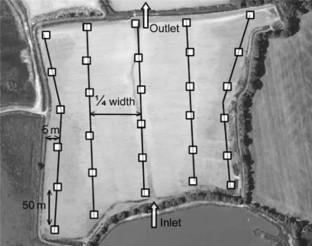Aquatic Ecology ( IF 1.8 ) Pub Date : 2023-06-05 , DOI: 10.1007/s10452-023-10032-y Joël Robin , Adeline Fontanilles , Soraya Rouifed , Mathieu Guerin , Marie Vanacker , Florent Arthaud , Alexander Wezel

|
Fish pond systems are managed with different practices. Among them, a dry period with one year without water is applied in some cases to promote mineralization of the sediments and control the development of pathogenic bacteria. This dry period induces a drastic disturbance on the plant communities. The objective of this work was to study the influence of a one-year dry period applied every five to seven years on aquatic plant diversity and abundance. For this, we studied the aquatic plant community of 149 fish ponds during the first year after a dried period (Y1), and ponds with a dried period dating back two years (Y2), three years (Y3), four years (Y4) and five to seven years (Ysup5). According to Jackknife index, mean species richness was highest for Y1, with 29 species compared to the other years (24 species for Y2; 19 for Y3; 15 for Y4 and 17 for Ysup5). A total of 15 species were identified as species unique to Y1 and were competitive, fast colonizer and disturbance-tolerant species. Most of these Y1 species developed during the dry year and remain only one year after refilling. After Y1, the evolution of communities was linked to the phenomenon of nestedness based on a loss of several species but not on a complete turnover, with most of species present independently of time. We conclude that a periodic dry period maintains a cycle in plant succession and accommodates highest species richness at the beginning of the cycle.
中文翻译:

临时干旱期后鱼塘水生植物群落的干扰和恢复能力
鱼塘系统采用不同的做法进行管理。其中,有的采用一年停水的枯水期,以促进沉积物矿化,控制病原菌的生长。这个干旱期对植物群落造成了剧烈的干扰。这项工作的目的是研究每五到七年应用一年的干旱期对水生植物多样性和丰度的影响。为此,我们研究了 149 个鱼塘在干旱期后第一年(Y1)和干旱期可追溯到两年(Y2)、三年(Y3)、四年(Y4)的池塘的水生植物群落。五到七年(Ysup5)。根据 Jackknife 指数,Y1 的平均物种丰富度最高,与其他年份相比有 29 种(Y2 24 种;Y3 19 种;Y3 19 种)。Y4 为 15,Ysup5 为 17)。共有 15 个物种被确定为 Y1 特有的物种,并且是竞争性的、快速定殖的和耐干扰的物种。这些 Y1 物种中的大多数在干旱年份发育,并且在再灌注后仅保留一年。Y1 之后,群落的演化与嵌套现象有关,这种现象基于多个物种的损失,而不是完全的更替,大多数物种的存在与时间无关。我们得出结论,周期性干旱期维持植物演替的循环,并在循环开始时容纳最高的物种丰富度。Y1 之后,群落的演化与嵌套现象有关,这种现象基于多个物种的损失,而不是完全的更替,大多数物种的存在与时间无关。我们得出结论,周期性干旱期维持植物演替的循环,并在循环开始时容纳最高的物种丰富度。Y1 之后,群落的演化与嵌套现象有关,这种现象基于多个物种的损失,而不是完全的更替,大多数物种的存在与时间无关。我们得出结论,周期性干旱期维持植物演替的循环,并在循环开始时容纳最高的物种丰富度。



























 京公网安备 11010802027423号
京公网安备 11010802027423号